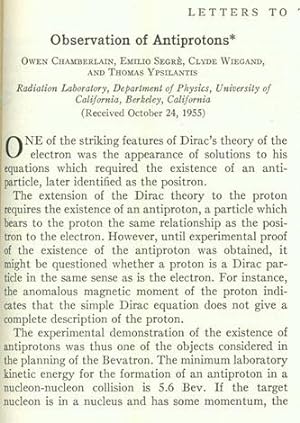Chamberlain, Owen; Segre, Emilio Et Al (3 results)
Product Type
- All Product Types
- Books (3)
- Magazines & Periodicals
- Comics
- Sheet Music
- Art, Prints & Posters
- Photographs
- Maps
-
Manuscripts &
Paper Collectibles
Condition
- All Conditions
- New
- Used
Binding
- All Bindings
- Hardcover
- Softcover (2)
Collectible Attributes
- First Edition (2)
- Signed
- Dust Jacket
- Seller-Supplied Images (1)
- Not Printed On Demand
Seller Location
Seller Rating
-
ANTIPROTON INTERACTION CROSS SECTIONS; EXPERIMENTS WITH 315-MEV POLARIZED PROTONS I. ELASTIC SCATTERING BY COMPLEX NUCLEI; EXPERIMENTS WITH 315-MEV POLARIZED PROTONS: PROTON-PROTON AND PROTON-NEUTRON SCATTERING ; POLARIZATION IN THE ELASTIC SCATTERING OF DEUTERONS FROM COMPLEX NUCLEI IN THE ENERGY REGION 94 TO 157 MEV - 4 articles in 3 complete issues of PHYSICAL REVIEW
Publication Date: 1956
Seller: Xerxes Fine and Rare Books and Documents, Glen Head, NY, U.S.A.
Condition: VG. Four articles in 3 separate complete issues of The Physical Review. First two articles are in volume 102 second series. number 6, June 15, 1956 . Third article is in The Physical Review vol 103, no 5, September 1956 and fourth in vol 105 , no. 1, January 1, 1957. first edition. 4to. Green printed wraps. Many additional articles in the issues as well . VG , text clean and binding secure. owner name stamp on front cover. Light cover wear. Three separate issues of Physical Review:
-
(New York), American physical Society, 1955. Lex8vo. In the original printed blue wrappers. In "The Physical Review", Volume 100, No. 3, November 1, 1955. Previous owner's stamp (Danish physicist C. Møller) to front wrapper. A very nice and clean copy externally as well as internally. Pp. 947-50. [Entire issue: 763-979]. First printing of Chamberlain, Segré, Wiegand and Ypsilantis landmark paper in which they first presented their discovery of antiprotons. Chambelain was together with Segré in 1959 awarded the Nobel prize in physics "for their discovery of the antiproton".The detection of the antiproton was first achieved in the fall of 1955 by the Berkeley physicists Owen Chamberlain [et al]. Their scintillators and Cerenkov counters showed about 60 antiproton condidates, but the ultimate proof of the particle, its annihilation with an ordinary proton, was not immediatedly confirmed. (Kragh, Quantum Generations). Since 1955, the antiparticles of many other subatomic particles have been created in particle accelerator experiments. In recent years, complete atoms ofantimatter have been assembled out of antiprotons and positrons, collected in electromagnetic traps.
-
Observation of antiprotons
Publication Date: 1955
Seller: Jeremy Norman's historyofscience, Novato, CA, U.S.A.
First Edition
First edition. Discovery of the Antiproton Chamberlain, Owen (1920-2006), Emilio Segrè (1905-89) et al. Observation of antiprotons. In The Physical Review, 2nd series, 100 (1955): 947-50. Whole number. 763-979pp. 268 x 202 mm. Original printed wrappers, vertical crease in back wrapper. Boxed. First Edition, journal issue. Segrè and Chamberlain, colleagues at the University of California, Berkeley, shared the 1959 Nobel Prize in physics for their discovery of the antiproton, a particle with the same mass and spin as the proton but with opposite charge and magnetic moment. Such antiparticles had been predicted in 1928 by Dirac's relativistic theory of the electron, and the first such particle, the positron, had been discovered by C. D. Anderson in 1932. Several rival groups at Berkeley also entered the antiproton hunt, but the Segrè team's experimental ingenuity insured its triumph: "I decided to attack the problem in two ways. One was based on the determination of the charge and mass of the particle. The other concentrated on the observation of the phenomena attendant on the annihilation of a stopping antiproton. The stopping antiproton and a proton of the target should mutually annihilate each other, and the rest mass of the two particles should transform itself in one of many possible ways into other particles such as pions. These would leave tracks in a photographic emulsion and the annihilation would thus become evident. . . . "We started the run on August 25, 1955, and after a few days of tuning up, we began observing antiproton signals. We based the identification on measurement of the velocity, momentum, and charge of a particle. The signals for velocity were oscilloscope traces recording the passage of a particle through a velocity-selecting Cerenkov detector. . . . We detected about one antiproton for every few hundred thousand other particles crossing our apparatus. . . . We decided to write a letter to the Physical Review and an article for Nature. . . . The mass-spectrograph experiment concluded on October 1, 1955, having proved the existence of the antiproton, and soon thereafter the emulsion work confirmed it" (Segrè, A Mind Always in Motion, pp. 256-57). .



